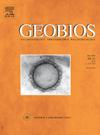Palaeoecological insight into the Badenian Sea – Middle Miocene palaeoenvironments from the North Croatian Basin, Central Paratethys
IF 1.6
4区 地球科学
Q2 PALEONTOLOGY
引用次数: 0
Abstract
During the Badenian (Langhian–early Serravallian), a high diversity marine biocenosis inhabited the warm, normal-salinity environments spanning the epicontinental sea of the Alpine-Carpathian-Dinarides region known as Central Paratethys. The 95 m thick sedimentary succession of the Striježevica core, located in the southwestern part of the Pannonian Basin (North Croatian Basin), provides a unique insight into the palaeoenvironmental evolution from this part of the Paratethys, including changes in water depth, salinity, oxygen, and nutrient levels. An integrated analysis, including calcareous nannoplankton, dinoflagellate cysts, benthic and planktonic foraminifera, ostracods, and diversity proxies, revealed three phases of palaeoenvironmental evolution. The stratigraphic position of the studied succession in the NN4/5 Zone is indicated by the nannoplankton assemblage with Helicosphaera waltrans, along with the presence of the planktonic foraminifera Orbulina suturalis, and the dinoflagellate cyst Unipontidinium aquaeductus, correlated to the Middle Miocene Badenian stage. Micropalaeontological proxies indicated shelf to upper slope environments under the influence of shallow-water conditions. At the base of the Striježevica core, the composition of small benthic foraminiferal assemblages and their diversity indices indicated a eutrophic-mesotrophic environment with constant nutrient input. A “transitional environment” in the middle part of the Striježevica core was characterized by eutrophication related to the fertilization effect of enhanced volcanic activity in the surrounding area. A shallowing upward trend is suggested by an increase in oxygen content at the sea bed, a decrease in species richness, and a diversity drop in the benthic foraminiferal assemblage. The upper part of the section depicted a shallow, oligotrophic environment with seagrass meadows evidenced by the predominance of Biasterigerina planorbis and cibicidoids.
巴登尼亚海-中中新世古环境的古生态学研究
在巴登纪(朗吉安-塞拉瓦利亚早期),一个高度多样化的海洋生物群落生活在温暖、正常盐度的环境中,横跨阿尔卑斯-喀尔巴阡山脉-迪纳里德斯地区的陆表海,被称为中央帕拉提提斯。位于Pannonian盆地(北克罗地亚盆地)西南部的Striježevica岩心的95 m厚的沉积演替,为研究Paratethys部分的古环境演化提供了独特的视角,包括水深、盐度、氧气和营养水平的变化。综合分析钙质纳米浮游生物、鞭毛藻囊、底栖和浮游有孔虫、介形虫和多样性指标,揭示了古环境演化的三个阶段。NN4/5带研究演替的地层位置由waltrans Helicosphaera的纳米浮游生物组合、Orbulina suturalis的浮游有孔虫和Unipontidinium aquaeductus的鞭毛藻囊指示,与中中新世巴登纪有关。微体古生物学指标表明,受浅水条件影响的陆架-上坡环境。在Striježevica岩心底部,小型底栖有孔虫组合的组成及其多样性指数表明其为富营养化-中营养化环境,营养输入恒定。Striježevica岩心中部的“过渡性环境”以富营养化为特征,这与周围火山活动增强的施肥效应有关。海底含氧量的增加、物种丰富度的减少和底栖有孔虫组合的多样性下降表明了浅层上升趋势。剖面上部为浅层贫营养环境,以Biasterigerina planorbis和cibicidoids为主,可见海草草甸。
本文章由计算机程序翻译,如有差异,请以英文原文为准。
求助全文
约1分钟内获得全文
求助全文
来源期刊

Geobios
地学-古生物学
CiteScore
3.30
自引率
6.20%
发文量
28
审稿时长
6-12 weeks
期刊介绍:
Geobios publishes bimonthly in English original peer-reviewed articles of international interest in any area of paleontology, paleobiology, paleoecology, paleobiogeography, (bio)stratigraphy and biogeochemistry. All taxonomic groups are treated, including microfossils, invertebrates, plants, vertebrates and ichnofossils.
Geobios welcomes descriptive papers based on original material (e.g. large Systematic Paleontology works), as well as more analytically and/or methodologically oriented papers, provided they offer strong and significant biochronological/biostratigraphical, paleobiogeographical, paleobiological and/or phylogenetic new insights and perspectices. A high priority level is given to synchronic and/or diachronic studies based on multi- or inter-disciplinary approaches mixing various fields of Earth and Life Sciences. Works based on extant data are also considered, provided they offer significant insights into geological-time studies.
 求助内容:
求助内容: 应助结果提醒方式:
应助结果提醒方式:


